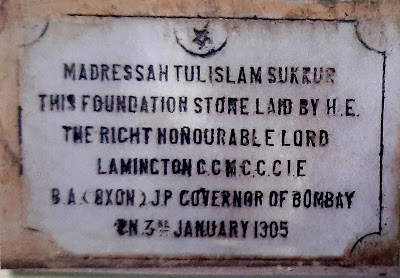Exploring Sadh Belo: A Hidden Gem on the Indus River
 |
| Sunset at Sadh Belo Temple: A Tranquil Scene on the Indus River |
The History of Sadh Belo
 |
Sadh Belo’s origins trace back to 1823, when Baba Bankhandi Maharaj established this religious sanctuary on a small island in the Indus River. Known as the "Forest of Saints," the name reflects its wooded surroundings and sacred ambiance. Official maps from 1893-4 and a detailed survey ordered by the Sukkur Collectorin 1912 (letter N.4402, dated February 13, 1912) confirm the island’s size at 629 acres, including its two inlets, Sadh Belo and Din Belo.
Over the centuries, Sadh Belo has remained a vital pilgrimage site for Hindus, surviving floods, political upheavals, and the partition of 1947. Its gaily painted buildings, though modern in construction, stand on a foundation of deep historical and spiritual significance. Today, it continues to draw devotees and travelers seeking a connection to Pakistan’s diverse past.
Architectural Beauty of Sadh Belo Temple
The temple complex of Sadh Belo is a striking blend of traditional Hindu architecture and natural splendor. Accessible only by boat, the island offers a picturesque riverside setting that enhances its charm. Here are some of its standout features:
- Arched Gateway: The main entrance is a grand, semi-circular archway adorned with intricate stonework. Flanked by smaller structures, it welcomes visitors with a sense of symmetry and reverence.
- Sturdy Stone Wall: A light-colored stone wall encircles the island, protecting it from the river’s currents. Its weathered surface hints at the passage of time, adding character to the site.
- Main Temple Building: Rising above the gateway is a multi-story whitewashed building, likely part of the temple’s residential or administrative quarters. A red flag atop the structure flutters gently, symbolizing its active religious role.
- Sacred Trees: Ancient banyan trees, sacred in Hindu tradition, dot the island, providing shade and contributing to its mystical "Forest of Saints" atmosphere.
- Vibrant Interiors: Inside the temple, dedicated to Lord Krishna, visitors can find carved pillars, domed roofs, and colorful frescoes depicting Hindu mythology, showcasing skilled craftsmanship.
The calm waters of the Indus River lap against the shore, reflecting the pale sky and creating a peaceful backdrop. The overcast light softens the scene, making Sadh Belo a photographer’s delight and a tranquil retreat for all who visit.
Why Sadh Belo Matters
Sadh Belo is more than a religious site it’s a cultural and historical treasure. In Pakistan, where Hindus are a minority, the temple stands as a symbol of tolerance and heritage preservation. For the Hindu community, it’s a place of pilgrimage held in high esteem across Sindh and India. For tourists, it offers a rare glimpse into the region’s architectural and spiritual legacy.
The temple’s location downstream of Bukkur Island and its separation by a short stretch of river add to its allure, making it a unique destination in the Indus River valley. It bridges the past and present, inviting visitors to appreciate Pakistan’s diverse tapestry.
How to Visit Sadh Belo
Planning a trip to Sadh Belo? Here’s everything you need to know:
- Location: Sadh Belo lies on an island in the Indus River near Sukkur, Pakistan, downstream of Bukkur Island. It’s accessible only by boat, adding an adventurous twist to the journey.
- Best Time to Visit: October to March offers cooler weather, ideal for exploring the temple and enjoying the riverside setting.
- How to Get There: Travel to Sukkur by road or rail from major cities like Karachi or Lahore. From Sukkur’s riverbank, hire a local boat for the short ride to the island.
- Visitor Tips:
- Obtain permission from the Department of Auqaf in advance, as it’s required for entry.
- Wear modest clothing to respect the religious site.
- Bring cash for boat fees and small offerings.
- Pack a camera to capture the serene beauty of the island.
- Nearby Attractions: Combine your visit with a trip to the Sukkur Barrage, an engineering marvel, or the historic Lansdowne Bridge, both just a short distance away.
The boat ride itself is a highlight, offering stunning views of the Indus River and the temple’s riverside silhouette. Whether you’re a pilgrim or a traveler, Sadh Belo promises a memorable experience.
 |
| The elegant arched gateway of Sadh Belo temple, located on the Indus River in Sukkur, Pakistan, with riverside steps leading to the sacred site, surrounded by lush trees. |
 |
 |
| A detailed marble statue of Swami Bakhandi Maharaj, the founder of Sadh Belo temple, depicted in a meditative pose at the temple in Sukkur, Pakistan, framed by ornate carvings. |
 |
 |
| The picturesque Sadh Belo temple complex along the Indus River in Sukkur, Pakistan, featuring whitewashed buildings and a small boat docked at the riverside, captured on January 28, 2007. |
Conclusion
Sadh Belo is a rare destination that blends history, spirituality, and natural beauty into one unforgettable package. From its founding in 1823 by Swami Bakhandi Maharaj Udasi to its enduring role as a pilgrimage site, the temple complex offers something for everyone. Its gaily painted buildings, sacred banyan trees, and tranquil riverside location make it a must-visit spot in Pakistan.
Have you explored Sadh Belo or another hidden gem along the Indus River? Share your experiences in the comments below, and subscribe for more travel insights!
References
- Wikipedia Sadh_Belo
- Pakistan Tourism Development Corporation
- Peepultree world
- Tripadvisor
- Sindh Culture, Tourism, and Antiquities Department
- Kalka Devi Temple is located in Rohri, Sukkur, Pakistan. It is a Hindu temple found in the Kalka hills. This temple is a significant religious site in Sindh.
- Rohri’s Masan: History, culture, and architecture of Sindh
References
- Books:
- Sindh and Its Sufis by J. P. Naik – Provides insights into the religious and cultural history of Sindh, including Sadh Belo’s establishment.
- The Indus Civilization by Mortimer Wheeler – Offers historical context on the Indus River region, including early surveys of islands like Sadh Belo.
- Hindu Temples of Pakistan by Ramesh Advani – Details the architectural and spiritual significance of Sadh Belo and its Udasi heritage.

















